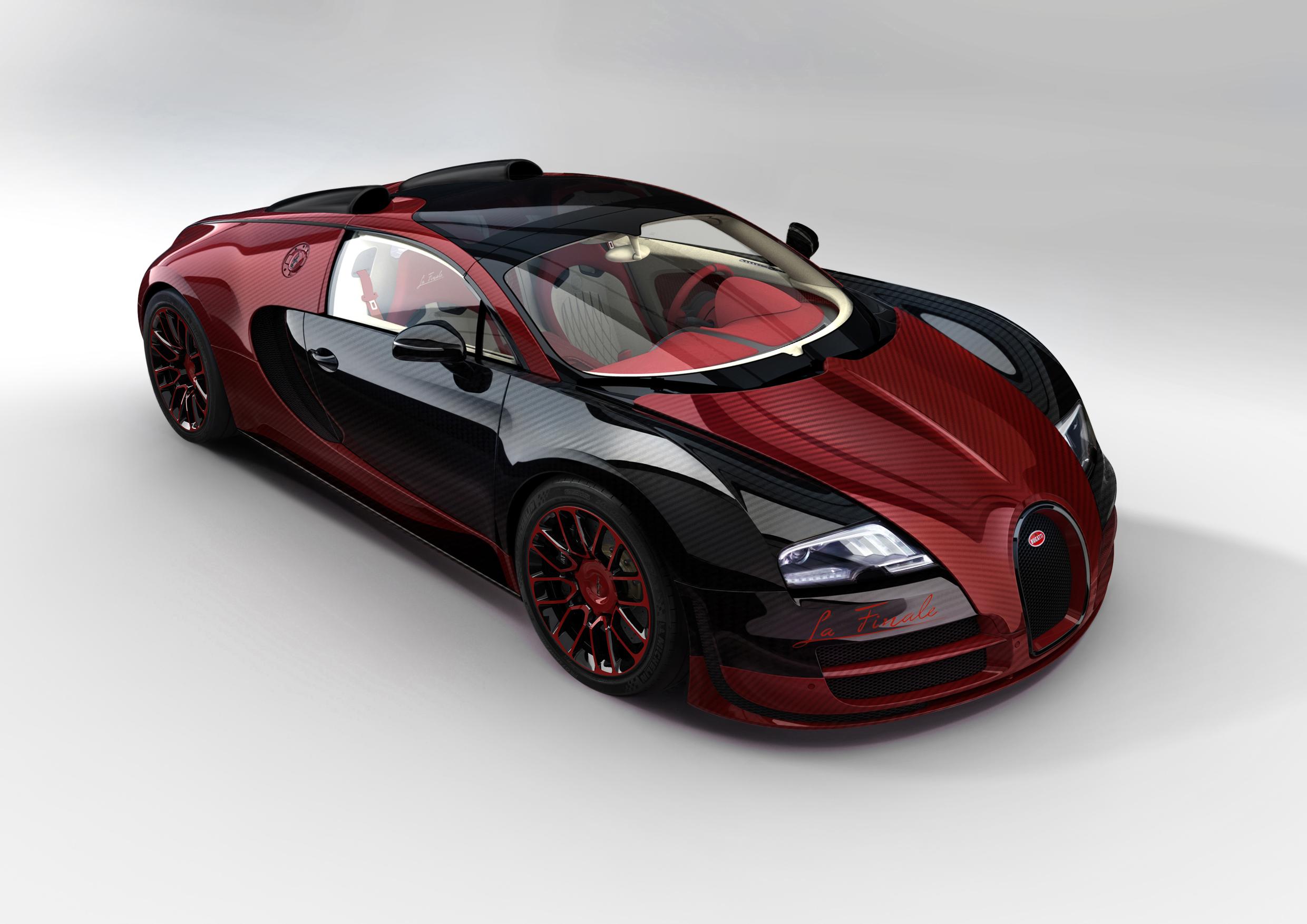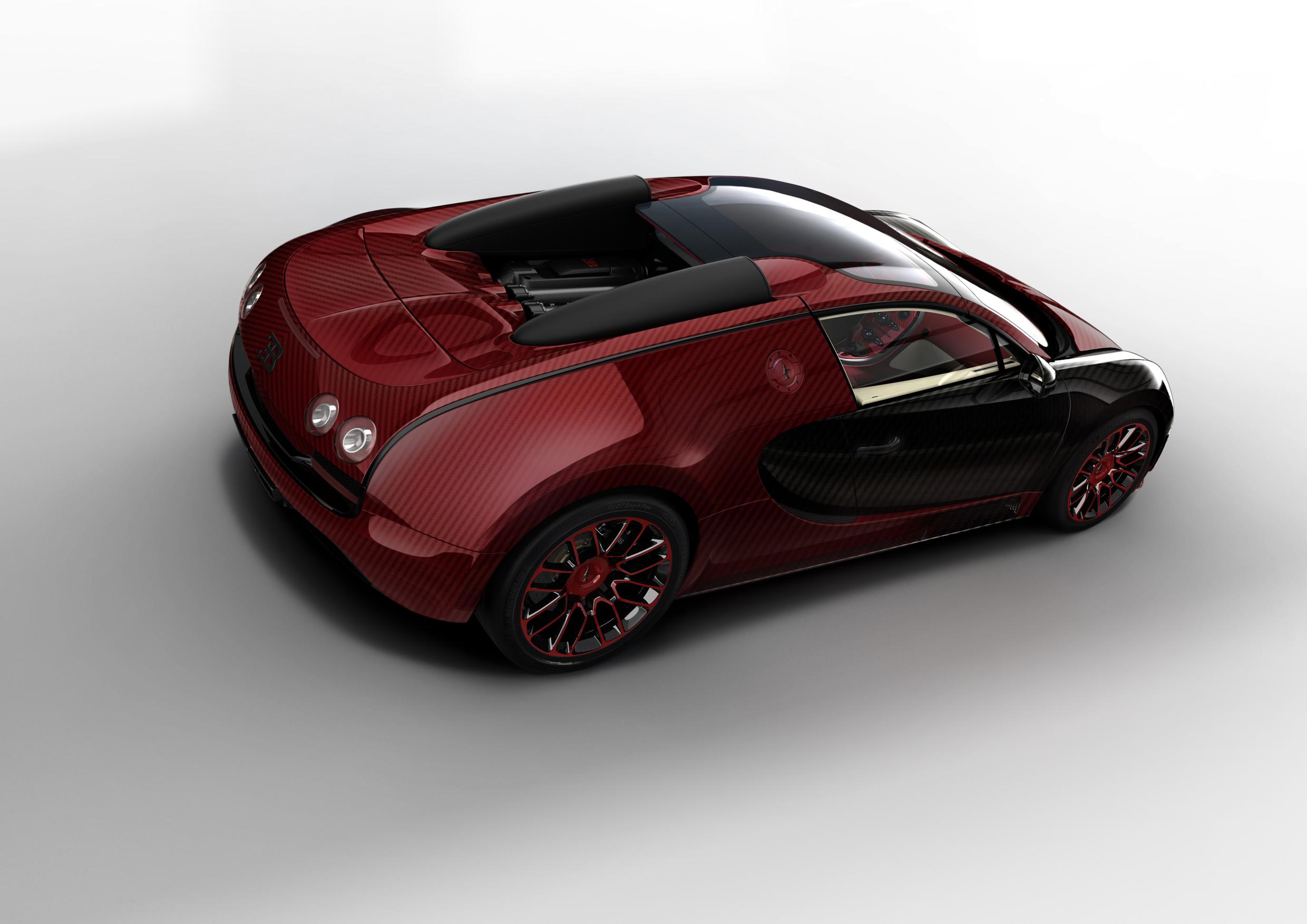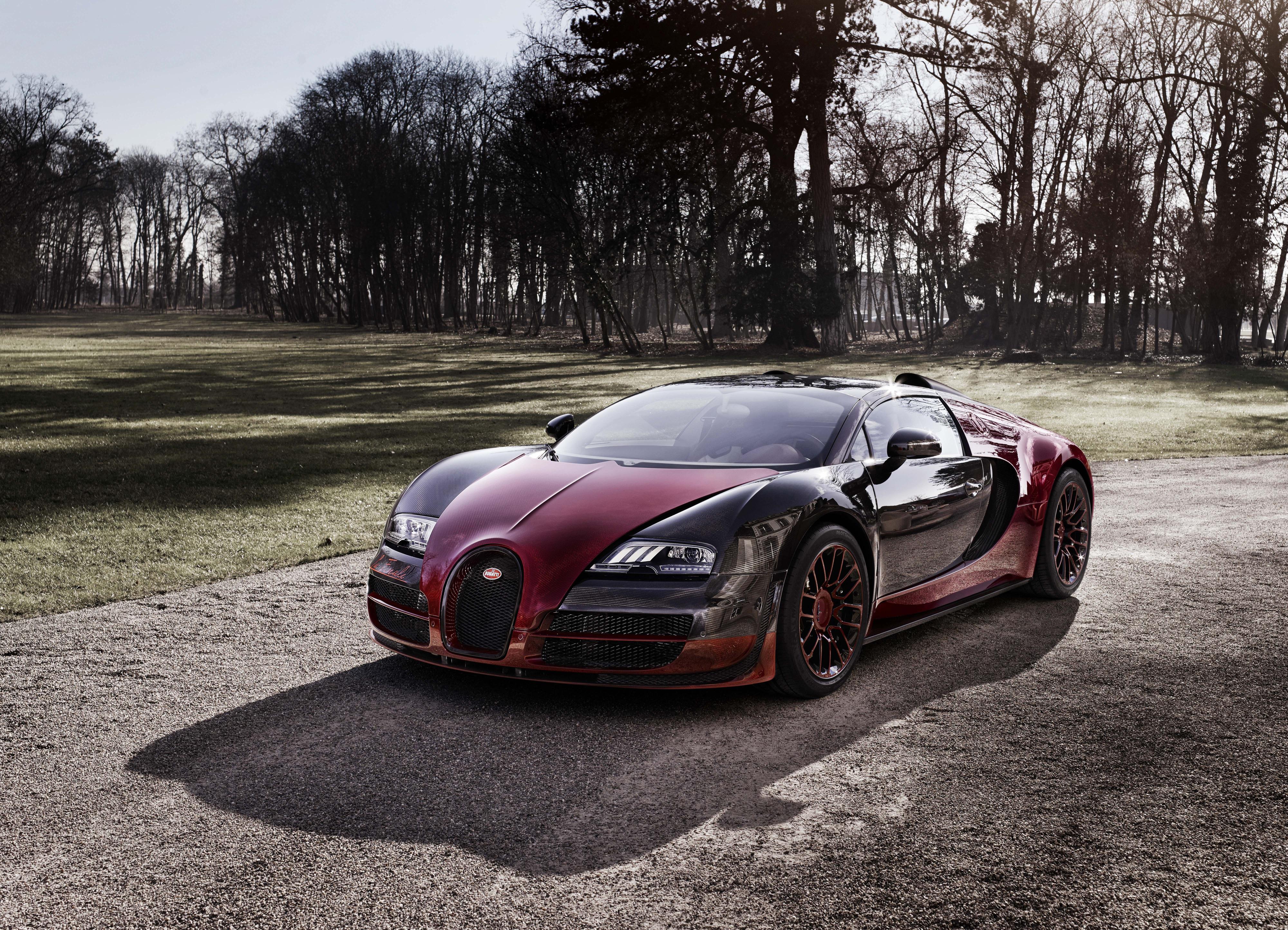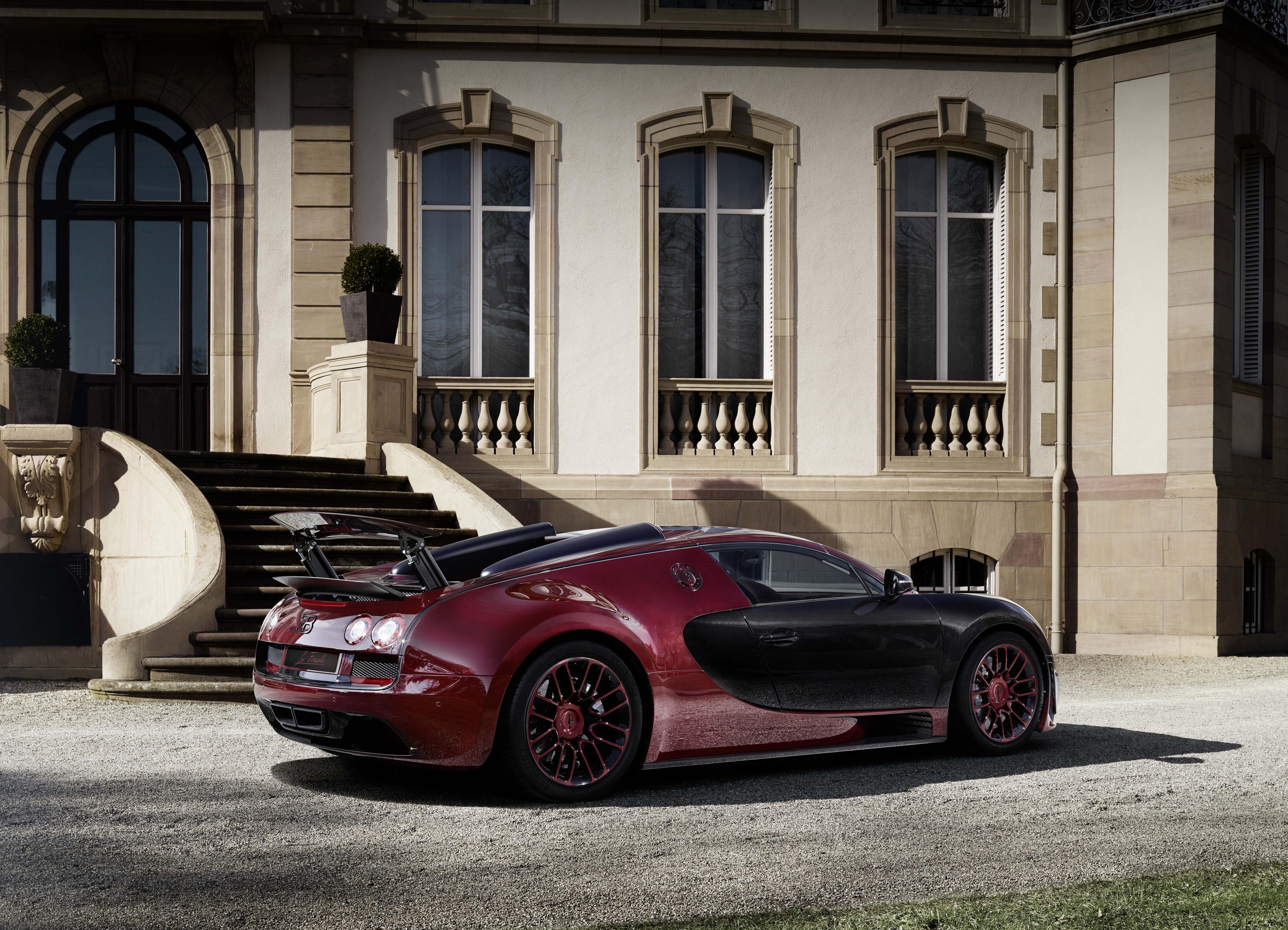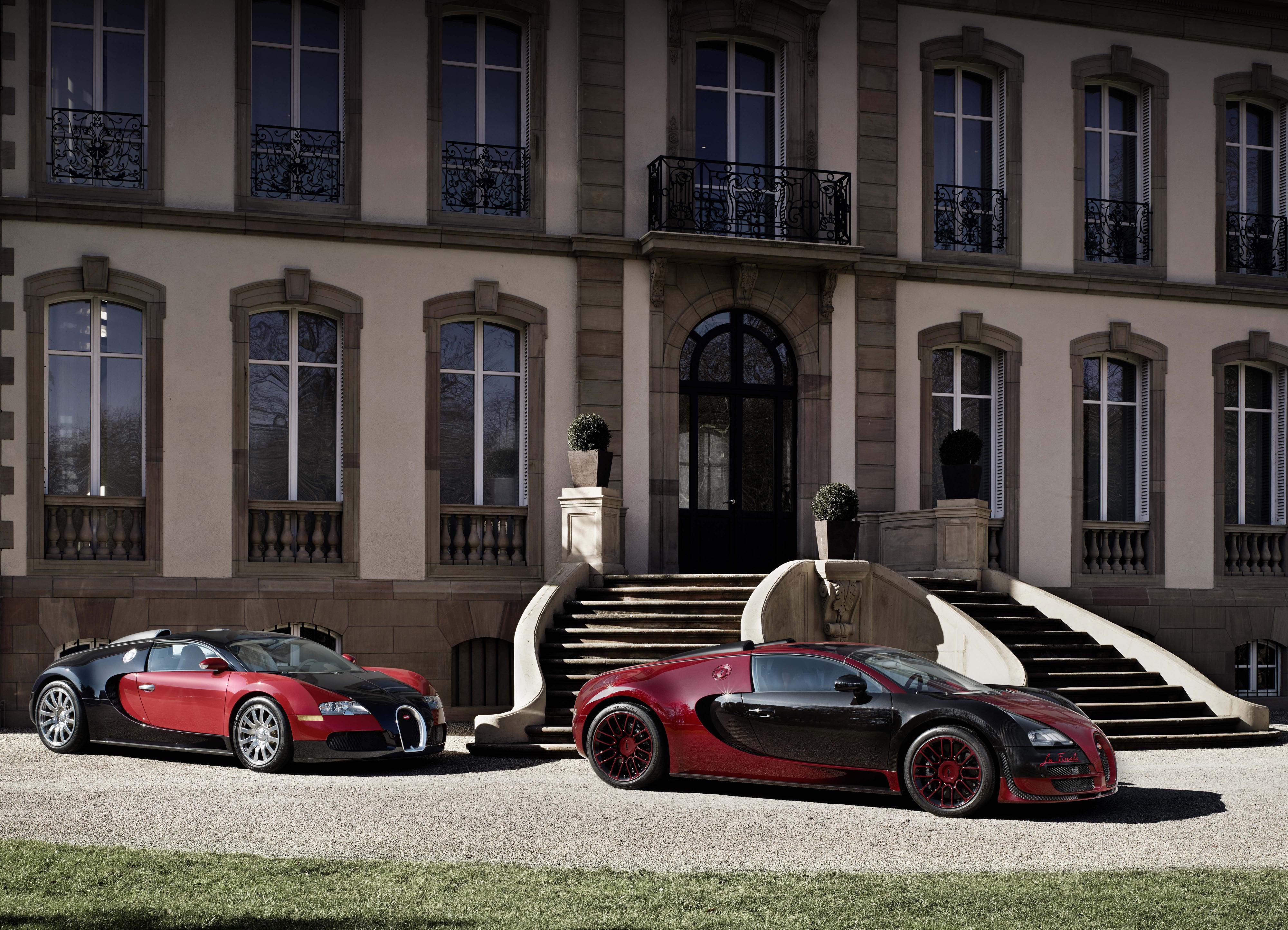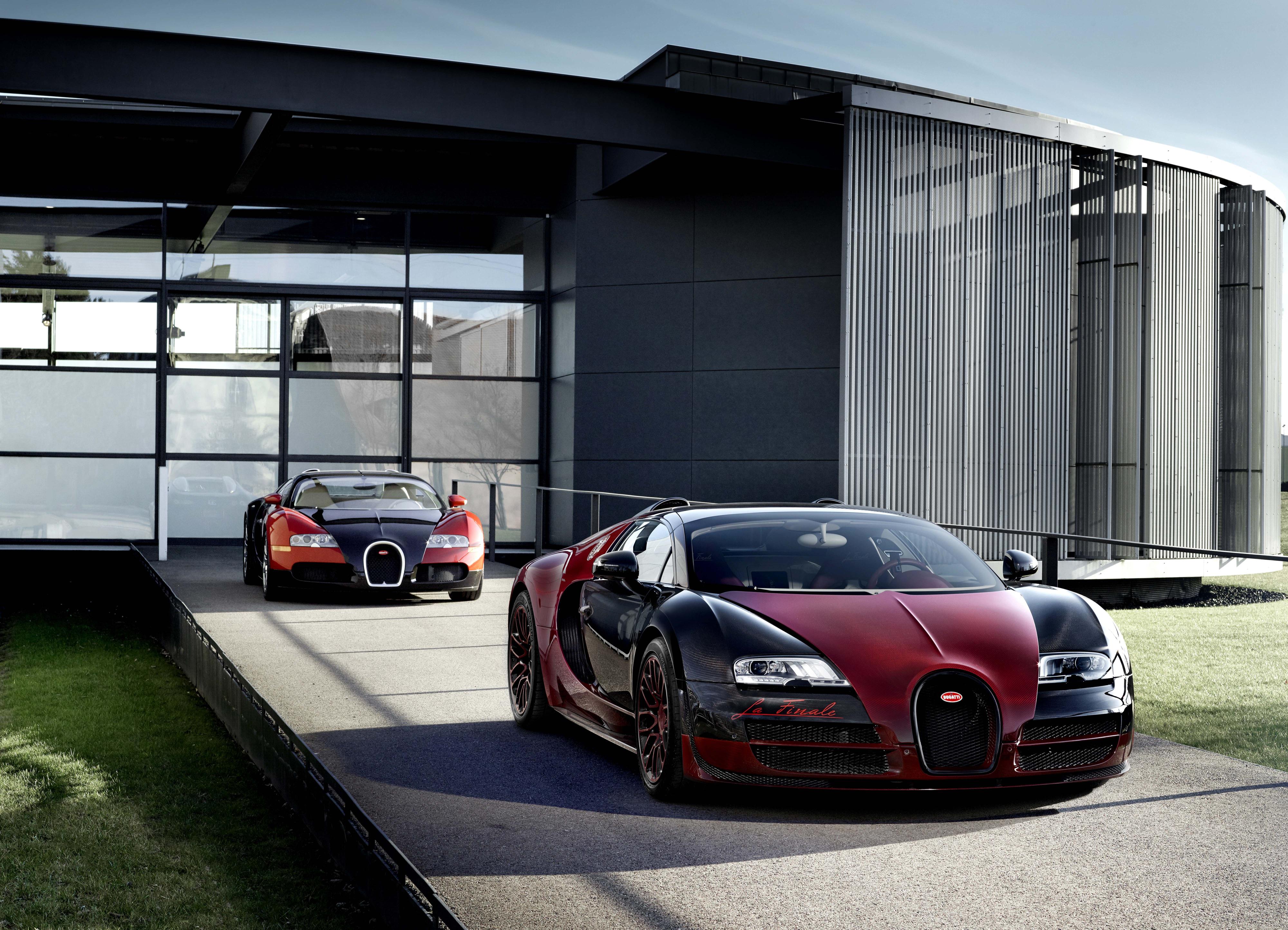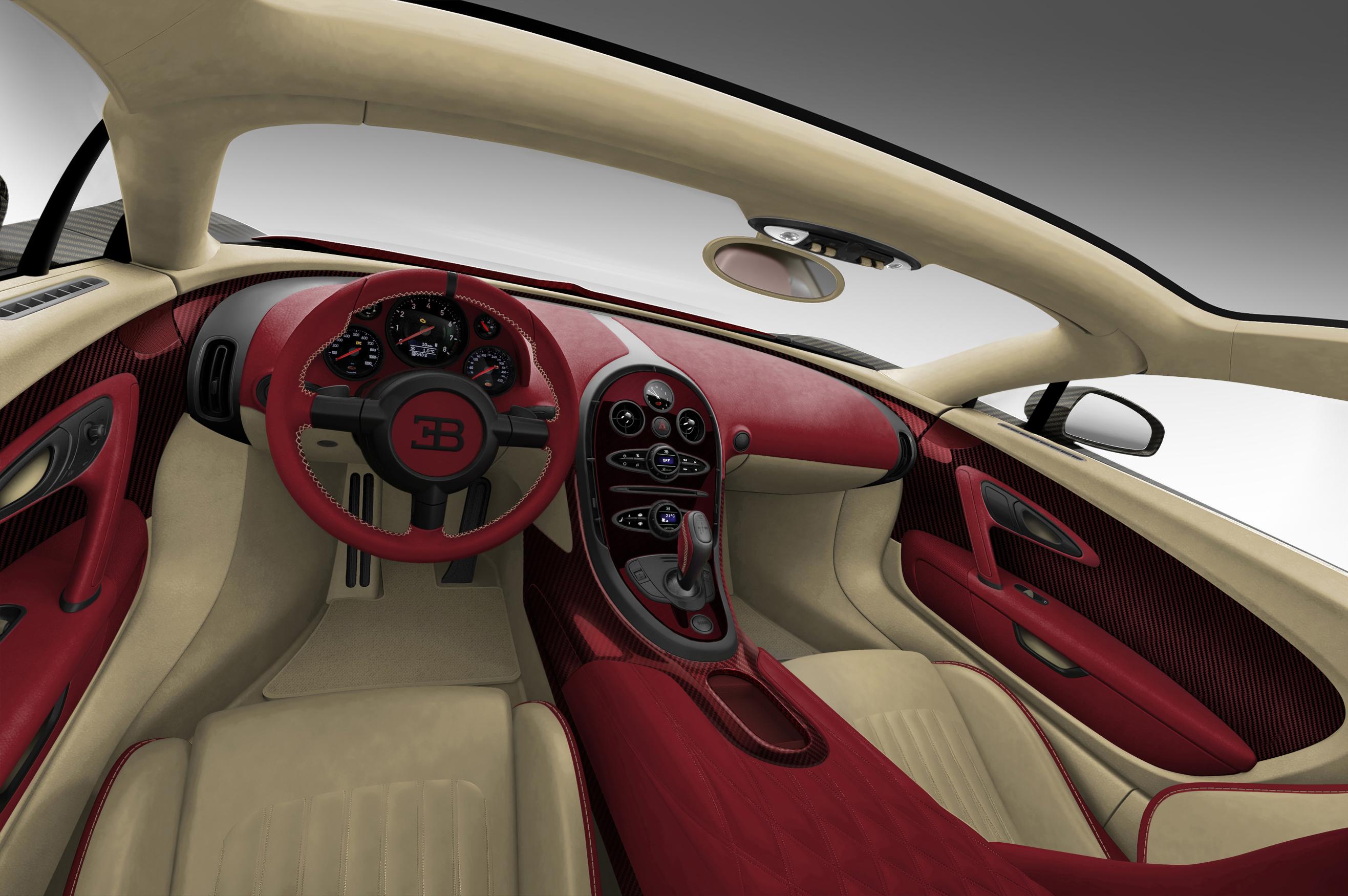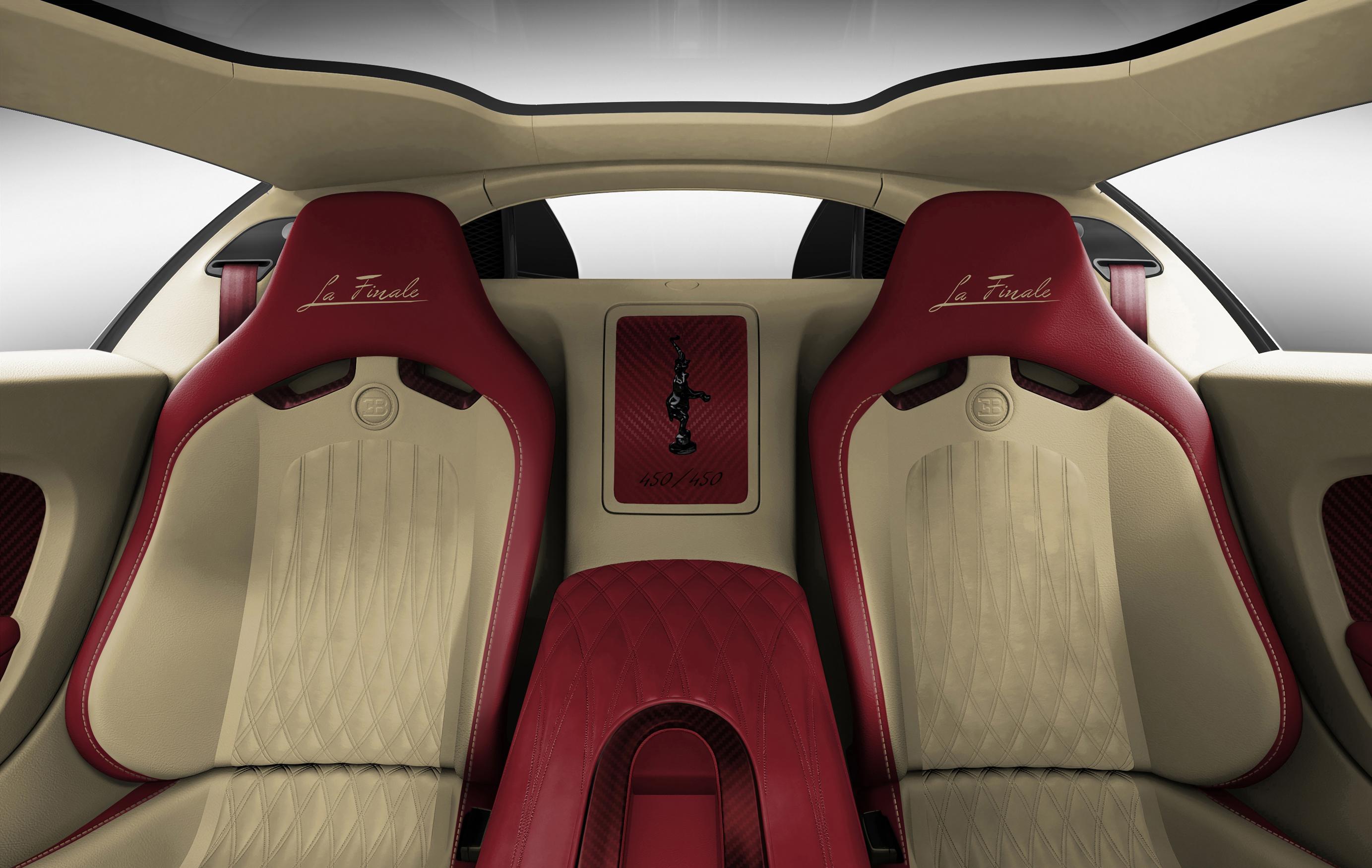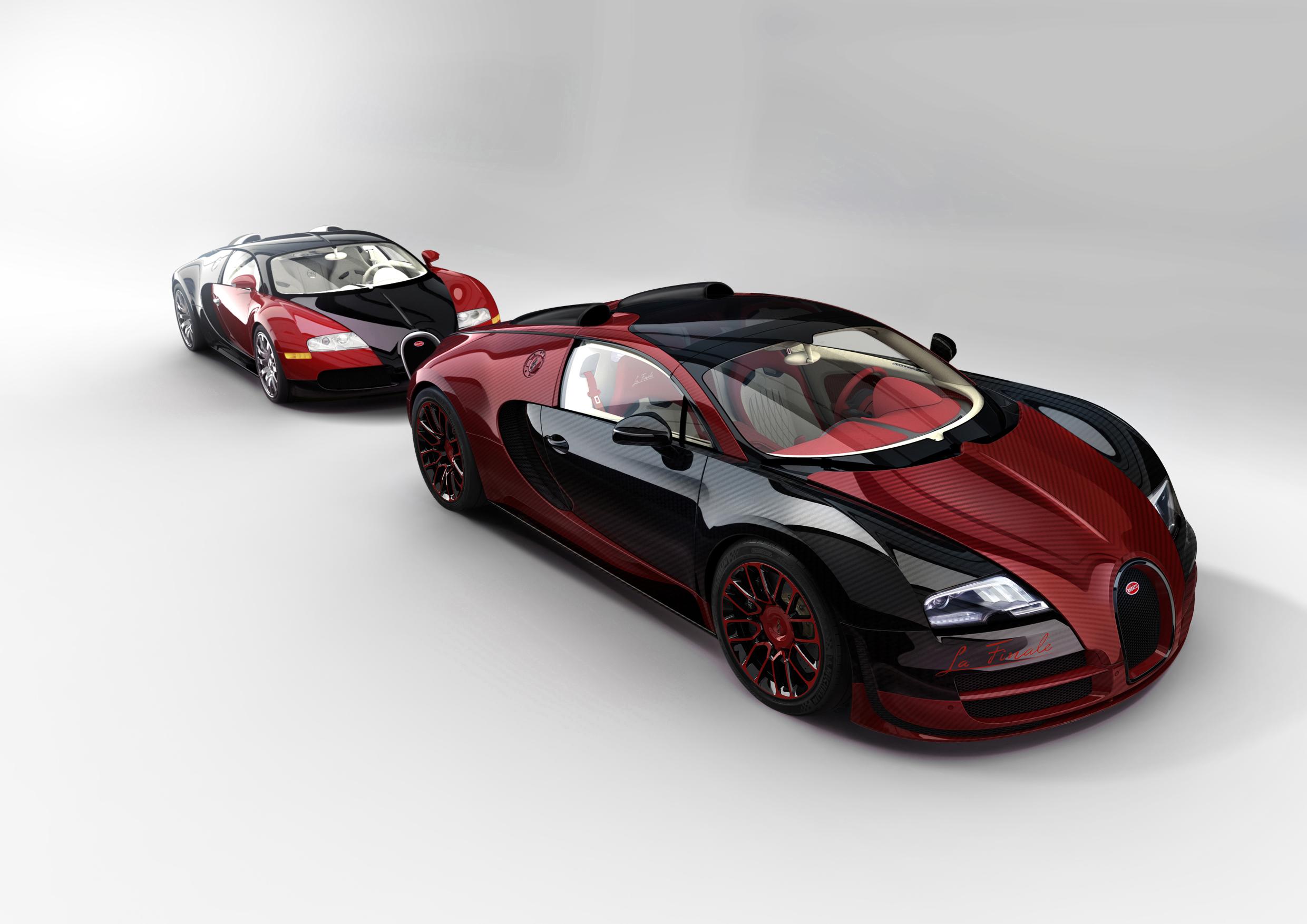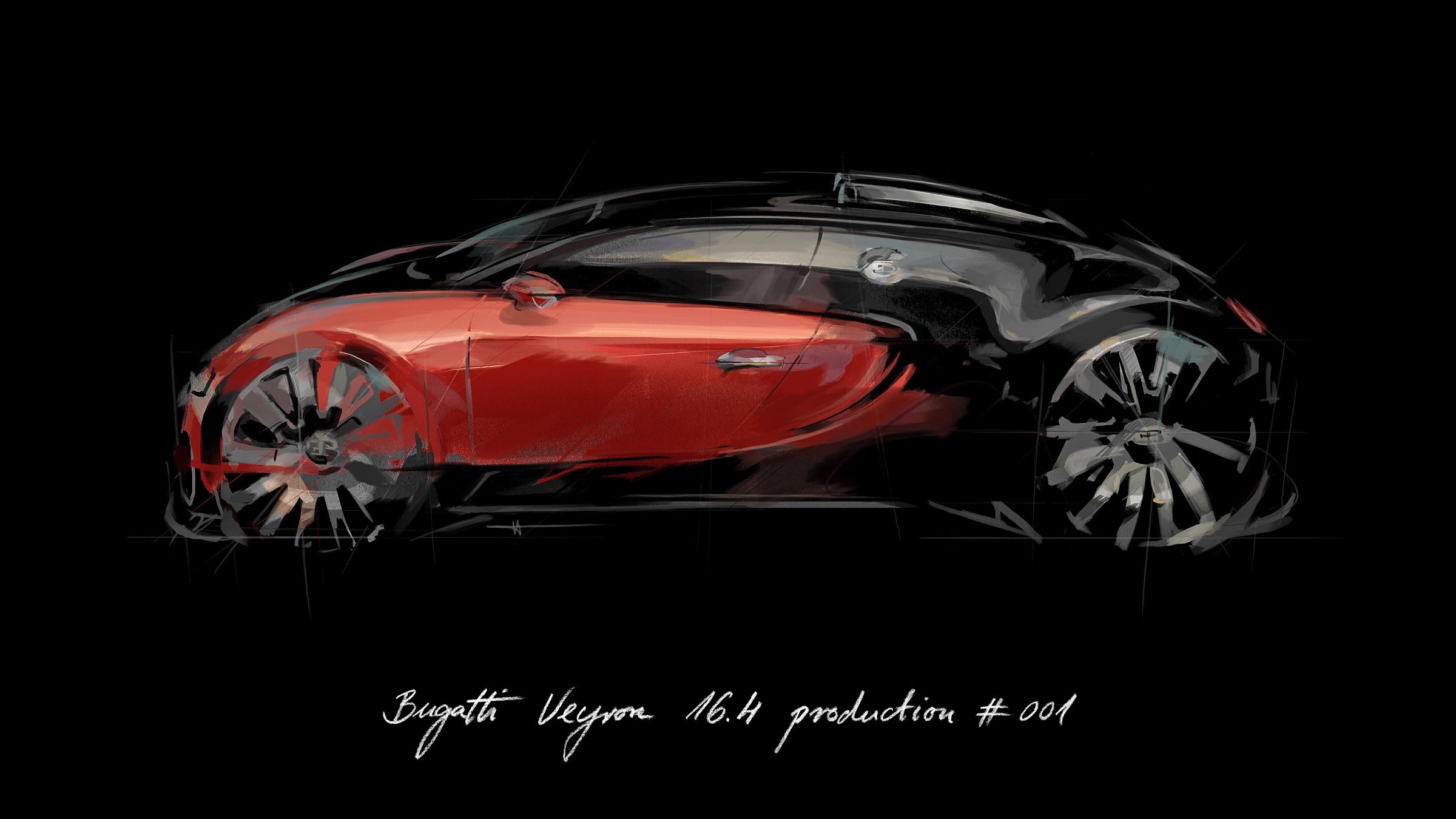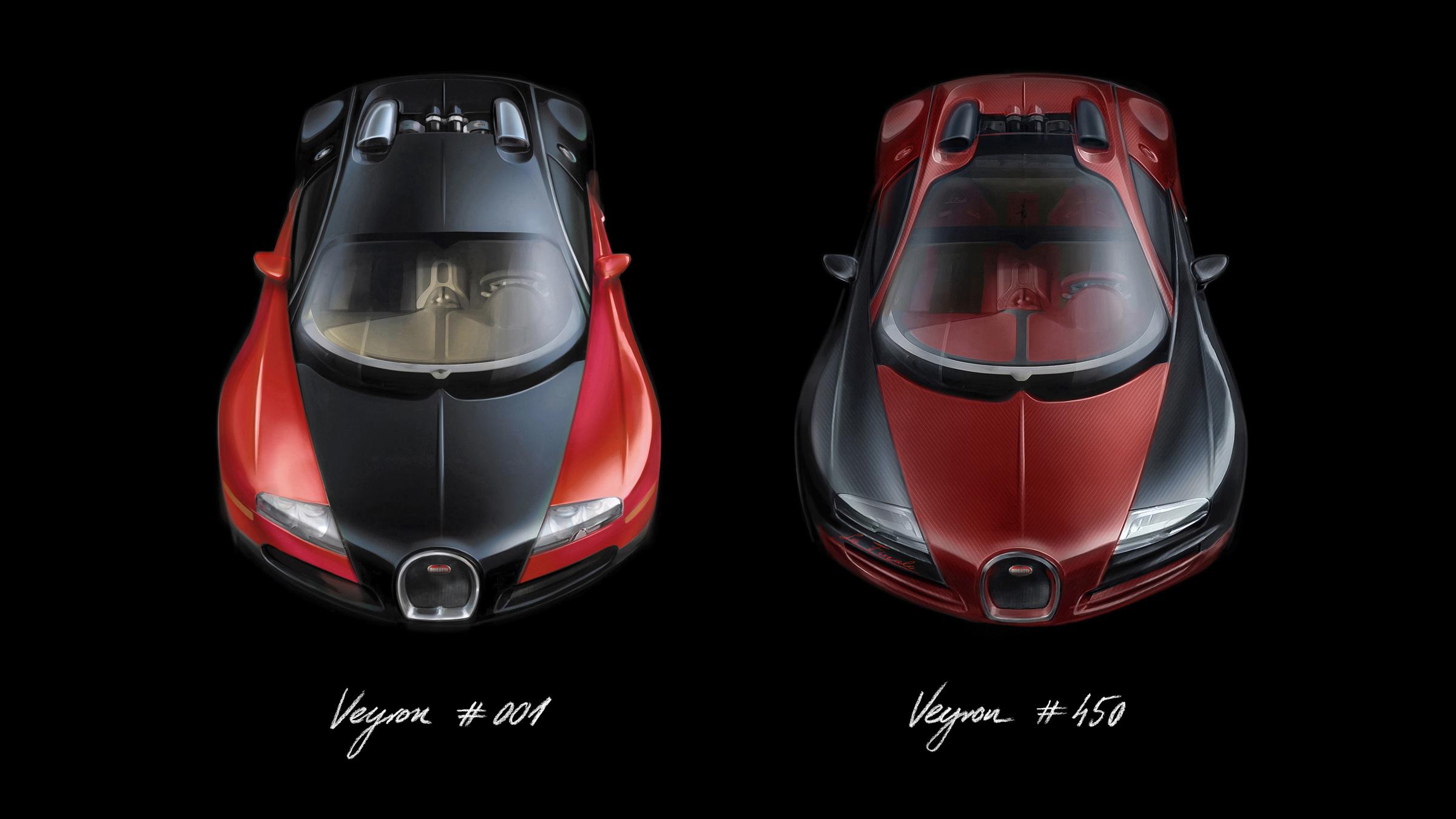- Bugatti President Wolfgang Dürheimer: “As the most powerful and fastest production supercar in the world, the Veyron is the benchmark”
- All 450 Veyrons have been sold, marking an important milestone for Bugatti
- The first and 450th Veyron will be on display together at the Geneva International Motor Show
Molsheim/Geneva, 2 March 2015. The curtain rises on an icon! At the Geneva International Motor Show, Bugatti is celebrating the Veyron, the fastest production supercar in the world whose performance has captivated legions of fans around the world since its launch ten years ago. The Veyron is limited to 450 units, which have now all been sold. The world première of the final Veyron in Geneva will mark the culmination of an unprecedented chapter in automotive history. Bugatti will showcase the Veyron 16.4 Grand Sport Vitesse “La Finale” with chassis number 450 alongside chassis number one of the Veyron 16.4 which rolled out of the company’s factory in Molsheim ten years ago and heralded the start of the Veyron’s success story.
“The Bugatti Veyron has shown that our engineers are capable of achieving a previously unimagined level of technical excellence, thereby opening up whole new dimensions in the automotive sector,” says Wolfgang Dürheimer, President of Bugatti Automobiles S.A.S. “The Veyron is justifiably at the head of the field.”
“As the most powerful and fastest production supercar in the world, the Veyron is a true benchmark,” continues Dürheimer. “With a world record speed of 431.072 km/h, it has become an icon of longitudinal dynamics.”
The development of the Bugatti Veyron represented one of the greatest technical and engineering challenges ever overcome in the automotive history. At the time, Bugatti developers were faced with four key specifications: the car had to transfer more than 1,000 PS onto the road, achieve a top speed in excess of 400 km/h, accelerate from 0 to 100 km/h in less than three seconds and – the biggest challenge of all – still be suitable for ‘driving to the opera’ in comfort and style.
In addition to its stunning performance, it is this everyday practicality and suitability for comfortable, luxurious travel which makes the Veyron so unique, and which sets it apart from all other supercars and hyper cars on the market.
This combination has proven to be a recipe for success. All of the planned 450 vehicles have now been sold: 300 coupés and 150 open-top super sports cars.
“So far no other carmaker has managed to successfully market a product that stands for unique top-class technical performance and pure luxury in a comparable price/volume range,” says Wolfgang Dürheimer. “This is an incredible success for Bugatti.”
Not only is the Veyron the epitome of premium performance and speed, it is also a prime example of timeless automotive design. The Veyron is an automotive piece of art featuring unique lines that are heavily influenced by the traditional design DNA of the Bugatti brand.
“The Veyron is a showcase for technology, design and art – in keeping with the Bugatti brand’s values of ’Art, Forme, Technique’”, Dürheimer says. Bugatti’s customers are as unique as its vehicles. “The Veyron has created an entirely new customer base for an automotive brand.”
“Alongside the certainty of owning the world’s fastest production sports car with a high degree of individual exclusivity, Bugatti customers appreciate that, by purchasing a Veyron, they become part of the history of an automobile brand that is steeped in tradition,” says the Bugatti President. “Many vehicles therefore find their way into private collections and are purchased as an investment by automotive connoisseurs.”
When it came to equipping the 450 Veyron sports cars, Bugatti did everything to fulfil customers’ wishes. For example, the body finish featuring clear-lacquered exposed carbon fibre was particularly popular. Bugatti currently supplies this finish in eight colours – more than any other manufacturer and in a quality that no other company can achieve. In addition, the French luxury brand offers over 100 different colours for the painted finishes on the carbon fibre bodies. The vehicles also feature a wide range of luxurious materials that were uncommon in the automotive field, such as porcelain, crystal, special types of leather and wood, gold and platinum. Each Bugatti configured by a customer is unique. Including options, the average price of the vehicles recently sold is €2.3 million.
It goes without saying that Bugatti is already working on the sequel to its recent success story, with development of its next model well underway. “With the next Bugatti model, we are aiming to consolidate and expand the market-leading position we have established with the Veyron,” the Bugatti President explains. “Our challenge is to make the best even better.”
The 450th Veyron: Grand Sport Vitesse “La Finale”
The last of the 450 Veyron supercars is the Veyron 16.4 Grand Sport Vitesse “La Finale”. It draws its sheer force from a 1,200 PS, 8-litre, W16 engine which provides a breathtaking maximum torque of 1,500 Nm. It sprints from zero to 100 km/h in just 2.6 seconds and can achieve a top speed of 410 km/h.
The “La Finale” design is a modern homage to chassis number 1
“When designing the “La Finale”, the designers sought inspiration from the first Veyron in order to provide a visual conclusion to the success story of this super sports car,” says Bugatti’s chief designer Achim Anscheidt. “Although both vehicles have a black and red colour scheme, chassis numbers one and 450 still have their own individual character which we have identified visually. Ultimately, every Veyron is unique.” The owner of the Grand Sport Vitesse “La Finale” also had a say in the design of the vehicle.
Première for red exposed carbon fibre
The design of the carbon bodywork of “La Finale” is based on chassis number one which was designed ten years ago in the traditional Bugatti two-tone colour scheme, which was popular in Bugatti models of the 1920s and 1930s. This striking design language remains inseparable from the Veyron to this day. For the “La Finale”, the front wing panels, the doors and the areas between the doors and the side air intakes, known as “medallions” in French, are made from black exposed carbon fibre. The other parts of the outer shell are made from red exposed carbon fibre, the first time this colour has ever been used on a vehicle. Including this new colour, Bugatti now offers a total of eight different tints for exposed carbon fibre. The French luxury brand is an industry leader in terms of not only the diversity of the colour schemes it offers, but also in relation to the quality and processing of the exposed carbon fibre.
Unusually for a Veyron, the name of the Grand Sport Vitesse has been incorporated into the outer shell. The “La Finale” lettering, which highlights the extra significance of this particular super sports car, appears twice: once very clearly under the right front headlight and then in a slightly concealed position on the underside of the rear wing. In both cases, the bright “Italian Red” lettering is painted into the black exposed carbon fibre.
For the first time in a Veyron, the air scoops and intercooler cover have been painted black. The EB logo and the relief “16.4” have also been emblazoned on it in Italian Red.
The wheel design is also in keeping with the red and black colour scheme. It is worth mentioning the hubcaps that were milled from a single block of aluminium – another example of the tremendous lengths that Bugatti goes to in the production of its vehicles. And that’s not all: each hubcap features a relief of the famous Bugatti elephant that was created during the milling process and then painted black. Rembrandt Bugatti, renowned sculptor and brother of company founder Ettore, designed this figure which was later used as a radiator cap on the Type 41 Royale and subsequently became a symbol of the brand. The elephant can also be found on the red fuel tank cover and oil cap as a black anodised insert made from milled aluminium.
An interior of strong, sophisticated contrasts
As with the exterior, the interior of the “La Finale” also pays tribute to the first Veyron. It was upholstered entirely in leather in a light beige colour known as “Silk”. Leather also adds a refined touch to the interior of the “La Finale”, where it features in the centre seat panels, the footwell, the headliner, the cowling and the rear wall. Unlike chassis number one, the designers and the customer have settled on contrasting colours for chassis number 450, selecting a striking red tone known as “Hot Spur”. This red appears in the arm rests, the instrument panel, the dashboard, the side bolsters and on the steering wheel rim, which is also decorated with stitching in “Silk” beige.
Red exposed carbon fibre is also used in the interior: on the centre tunnel, on the inserts in the centre console, on the door panels and seat shells.
The red head restraints are adorned with “La Finale” lettering embroidered in “Silk” colour. The lettering is found again in “Italian Red” in the door sill strips, etched into the black exposed carbon fibre.
The jewel in the interior is undoubtedly the Bugatti elephant on the stowage compartment cover made from red exposed carbon fibre and located in the rear panel between the seats. The elephant was cast in bronze with great technical skill, given a black patina, and then worked into the cover as an insert. The lettering “450/450” has been painted in black under the bronze cast.
The Geneva International Motor Show will be staged from 5 to 15 March 2015 at the Palexpo exhibition centre in Geneva. The Bugatti exhibit is in hall 1.
The impossible made possible
The Bugatti Veyron – a technical masterpiece
When the Bugatti Veyron was first announced at the end of the nineties, many people were sceptical that the basic parameters could ever work. With more than 1,000 PS, a top speed in excess of 400 km/h, acceleration from nought to one hundred in less than three seconds, the doubters thought it simply impossible to produce a super sports car with this level of performance while remaining controllable and drivable. But that’s not all. Bugatti had set the bar even higher with its intention to produce a comfortable road car that was suitable for everyday use.
The development of the Veyron was one of the most significant technical challenges ever undertaken by the automotive industry. Bugatti engineers had to push the limits of physics and do things that had never been done before in automotive development.
Structure and materials. Very few parts, components or systems from existing vehicle concepts could be used in the Veyron. Everything had to be developed from scratch to achieve the required performance before being incorporated into the vehicle. When creating the Veyron, designers regularly drew inspiration from other industries which required extreme speeds and demanded extreme stress loads from materials and systems.
One key objective in the development of this exceptional vehicle was to achieve maximum longitudinal and lateral dynamics combined with optimum safety for the driver and front passenger. To do so, the Bugatti development team came up with a winning combination of rigidity and lightweight construction for use in the fastest roadster in the world.
Bugatti selected materials with optimum characteristics for each area of the Veyron, designed specifically to cope with the relevant loads. Criteria included lightness, tensile strength, formability, heat resistance, and non-splintering.
The passenger compartment of the Veyron consists of extremely strong yet feather-light carbon fibre. Like a Formula 1 racing car, it is designed as a monocoque and weighs around 110 pounds. The rear of the monocoque contains a cavity modelled to house the 100-litre fuel tank. This central vehicle structure is completed by a fixed, highly complex frame structure at the front and rear. The torsional rigidity from axis to axis is approximately 45,000 Nm per degree, almost double that found in modern production sports cars. This excellent structural rigidity ensures extremely precise driving performance in bends, with excellent stability under braking and acceleration.
The engine and gearbox assembly and the supporting frame for the rear of the vehicle are mounted with carbon fibre brackets manufactured using a resin infiltration process. These components must endure continuous temperatures of up to 170 degrees due to their proximity to the exhaust system and turbochargers. Bugatti developed these new heat-resistant materials and production methods especially for the Veyron and thus for the automotive industry. Both have since found their way into the aviation industry.
The front end of the Veyron is firmly connected to the front of the monocoque and consists of a 34 kg lightweight aluminium frame structure which essentially performs two functions. Firstly, it holds the front end components including the front axle differential, the cooling packages, steering system and the battery. Secondly, the front end also acts as a crash structure that is designed to deform and absorb kinetic energy in the event of an accident.
Torsion-resistant and lightweight upper longitudinal members made from carbon fibre are mounted at the rear of the monocoque. A carbon fibre cross member bolted to the two longitudinal members forms the rear end of the frame structure.
Titanium was the first choice for the bolts used to connect the three parts of the vehicle – the front end, monocoque and rear chassis. The advantage of titanium bolts over steel screw bolts is that they provide maximum strength but weigh less, a feature that Bugatti drew from the aviation industry. The Veyron was the first production car in the automotive industry to use titanium bolts. It was also Bugatti that subjected these bolts to continuous load testing to ensure that they could be used in a vehicle.
Carbon fibre plays an important role in the Veyron due to its properties, which have been developed to withstand extreme loads, but also for aesthetic reasons. Bugatti is the market leader in exposed carbon fibre. No other manufacturer in the automotive industry manages to produce exposed carbon fibre of such immaculate quality. Material authenticity is the defining principle – everything is genuine, there is no overlamination. The carbon mats are grouped and superimposed by hand and with a keen eye for precision to ensure perfect, symmetrical alignment of the fibres on the vehicle body and other components. Up to twelve layers of lacquer and paint are then applied by hand, resulting in clear-coated carbon fibre with unparalleled colour depth and brilliance. Bugatti currently offers eight colours: blue, grey, black, green, brown, purple, turquoise, and now also red. No other manufacturer offers this range of colours. Exposed carbon fibre has since become an extremely popular option amongst Bugatti customers. Bugatti has also transferred this expertise to other Group brands for small series vehicles and certain customised options.
Engine. The heart and soul of the Veyron is the 8-litre W16 engine with four turbochargers, which initially generated 1,001 PS, and an incredible 1,200 PS in later models. The 16-cylinder mid-engine is 710 mm in length, no longer than a conventional V12 engine, and weighs just 490 kg due to its lightweight construction, despite its output. The engine is fully capable of operating under a continuous full load, a feat that engines designed for use in motor racing cannot achieve.
Its compact dimensions are due to the unique arrangement of its cylinder banks in a W configuration. Two VR8 blocks, each with a 15-degree bank angle, are joined in the crankcase to form one engine. Both eight cylinders are set at an angle of 90 degrees to each other and are aspirated by a total of four exhaust gas turbochargers.
The Bugatti development team created a hugely complex drive unit in order to convert the power output of the 64-valve engine into driving dynamics suitable for both everyday traffic and the race track. If the extreme engine power alone is an ingenious masterpiece, transferring it to the road was an equally demanding challenge.
Development work focussed on the engine’s extremely high performance, in addition to its unique compact nature. Lightweight materials are used that not only result in a low power-toweight ratio, but also provide a spontaneous response from the moving masses inside the engine. In addition to titanium piston rods, known as “easy runners”, the eight-stage oil pump integrated into the crankcase for dry sump lubrication has light aluminium gears. Only a small mass flywheel is required as the layout of the 16-cylinder engine already ensures smooth running. The use of motor sport technology is evident not only in the plasma-coated cylinder
running faces, but also in the use of high-strength steel for the shafts and gears in the aluminium crankcase.
Gearbox. The Veyron is equipped with the dual-clutch gearbox (DSG), which is the fastest gearbox in the world. Bugatti was the first manufacturer to use a seven-speed variant of the DSG. Designed specially for the new sports car, this gearbox has a job which any other gearbox would baulk at, i.e. to transfer engine torque of up to 1,500 Nm to the road surface.
At the time, the dual-clutch transmission used in the Veyron was a unique combination of the dynamic advantages of a manual gearbox with the convenience functions of automatic transmission. When it was developed, no other manufacturer outside of Volkswagen AG was using comparable gearbox technology.
Adaptive boost-pressure fuel injection. In a high-performance vehicle such as the Veyron, it is essential that the engine is always supplied with constant fuel pressure. This also required a new development, and so Bugatti invented three-phase injection pumps which, unlike conventional plus/minus polarised pumps, are able to supply the engine with the required amounts of fuel continuously at a constant pressure.
The fuel tank also had to be redesigned. Bugatti turned to the world of motorsport but had to rebuild the conventional fuel tank used in racing, which is not permitted for road vehicles, to ensure that it would be approved. Bugatti consulted engineers in the aerospace industry, and the outcome was a fuel tank with an external Teflon coating which provides the fuel pump with a constant supply of fuel in every situation, up to a residual capacity of three litres and maximum lateral acceleration of 1.4 g.
Cooling. Cooling is an extremely important aspect of the Veyron. Sophisticated airflow patterns were devised to conduct sufficient cooling air to the vehicle’s radiators and extract hot air without compromising the vehicle design – a key consideration.
During combustion, some 2,400 PS of additional heat is generated for every 1,200 PS of drive power. To cope with this, the Bugatti engine has two water circuits. The larger circuit contains 40 litres of coolant water in three coolers in the front section of the vehicle to keep the engine at operating temperature. The second, a low-temperature circuit with a separate water pump, contains 20 litres of coolant water. This system cools the charged air and helps to prevent the car from overheating in slow traffic, which is a common problem in high-performance sports cars.
Tyres. For the Veyron, Bugatti worked in partnership with Michelin to develop the world’s first mass-produced tyre that can withstand speeds in the region of 400 km/h. The production tyres can be used in all speed ranges, which means that the Veyron does not require a different set of tyres when being driven at maximum speed. This was an important criterion which the developers had to fulfill in relation to the vehicle’s everyday practicality.
One exciting detail of tyre development is the new tyre pressure sensor that had to be developed for the Veyron. Centrifugal forces of up to 130 kg are generated at speeds in excess of 400 km/h. This required extensive tests on a test stand used for aircraft gas turbines in order to simulate the high speeds of the Veyron wheels. At the time, this kind of system was not available in the automotive industry.
Brakes. Bugatti developed a high-performance braking system featuring unique components in order to control powerful forces effectively and bring the vehicle to a halt safely and quickly. Certain components were designed in conjunction with development partners from the aerospace industry.
Experiencing the Bugatti’s braking system in action is just as much of a thrill as the acceleration. Combined with the simultaneous application of the air brake, an aerodynamic braking function integrated into the rear wing, the Veyron generates deceleration values not encountered in any other production car.
The braking forces are distributed to a maximum of sixty percent on the front axle and forty percent to the rear axle.
Bugatti chose carbon-ceramic brake discs as the preferred material, the first time a company in the Volkswagen Group had done so, in order to achieve maximum braking performance and to withstand brake disc surface temperatures of 1,000 degrees. The relatively low material weight also greatly reduces unwanted impact on the steering. Titanium was used for the brake disc hub instead of the usual stainless steel. As a result, the Veyron had by far the strongest braking performance in the automotive industry and motorsport at the time.
The carbon disc brakes at the front are 400 millimetres in diameter (rear: 380 mm). An extremely rigid eight-piston monoblock caliper unit with four pads each, reinforced with a central bar and weighing just 5.7 kg, is used.
Variable aerodynamics. The Veyron’s design is an outstanding feature, which clearly sets the super sports car apart from other high-performance vehicles in the automotive industry. The shape and style of the Veyron are strongly based on the historical design DNA of the brand.
The strict requirement to stick to the design of the car did not always make life easy for the developers, and this was also the case in relation to the aerodynamics, which are clearly an essential element of a supercar.
The most important technical element on the Veyron, which solves the contradiction between design and aerodynamics, is the rear wing. At speeds above 200 km/h it provides additional optimisation of braking performance. The wing flips up to an angle of 55 degrees in less than 0.4 seconds, with important consequences. Firstly, it increases the rear downforce, thereby improving the distribution of braking power between the front and rear axles. Secondly, it increases the air resistance, as when an aircraft is landing. At high speeds, the air brake alone causes deceleration of up to 0.6 g. It is activated via the brake pressure. With standard tyres on appropriate road surfaces, the wheel brakes generate deceleration values of around 1.4 g. The Veyron can brake to a complete standstill from 400 km/h in under ten seconds.
Never before in automotive history did engineers have to set up a sports car for use on public roads, while being capable of the same ease and security of handling across such a wide range of speeds. The Bugatti team faced a major challenge when it came to maintaining a balance between what amounted to three aerodynamic requirement profiles. Firstly, the bodywork had to have minimum air resistance to ensure that it could still achieve extreme acceleration values in excess of 200 km/h and reach a maximum speed of more than 400 km/h. Secondly, the downforce conditions on the front and rear axles over the entire speed range had to be so sophisticated that the fastest production super car in the world would be as smooth as possible on the road. And thirdly, it was expected that all the extremely tightly-packed high-performance
cooling units under the outer shell would be supplied with optimum airflow at all times.
The aerodynamic management of the Veyron is a fascinating high-tech solution that is unparalleled in contemporary automotive engineering. A computer-controlled central hydraulic system is the heart of the regulatory framework. It regulates the ground clearance of the allwheel drive Veyron, using three speed-dependent levels. A front diffuser flap is installed on both sides of the underbody to increase the downforce. Both of these flaps open and close with the help of two hydraulic cylinders. The downforce at the rear is regulated by a diffuser in the underbody and by the rear spoiler.
Verdict. The Veyron’s incredible performance statistics have powered the automotive industry into new dimensions. In the process, Bugatti developed completely new technical solutions, some of which have found their way into other brands within the Group and beyond, and have even been used in other industries.
The Veyron is the first and only super sports car designed and built to handle any driving situation at any time in its production configuration. Where other super sports cars and hyper cars require special preparation for individual driving situations, the Veyron automatically adjusts its settings at lightning speed without any input from the driver. It can set itself up for maximum acceleration on long straights, twisty country roads or city traffic, ensuring that the Veyron always has an optimum setup to provide a comfortable ride.
The Veyron 16.4 was launched in 2005 and provided impressive evidence of just what Bugatti developers had achieved. This marked the beginning of a great success story, which continued in 2008 with the launch of the open version – the Veyron 16.4 Grand Sport with 1,001 PS. In 2010, the Veyron 16.4 Super Sport with increased power of 1,200 PS was launched and was then joined by the roadster version, the Veyron 16.4 Grand Sport Vitesse, in 2012.

